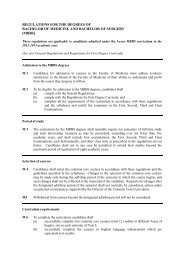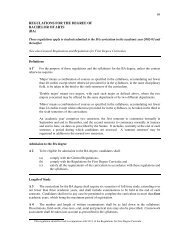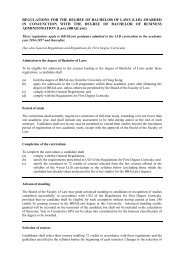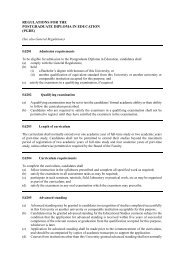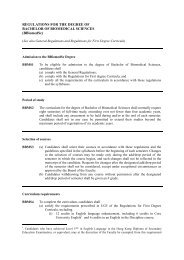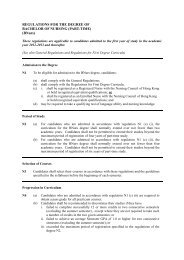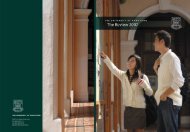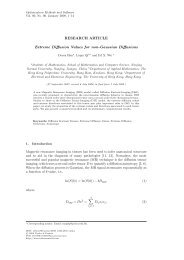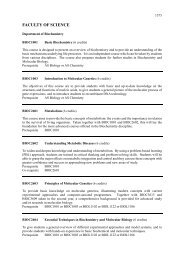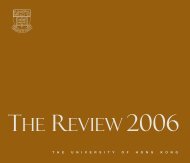(BA) (4-year-programme) - The University of Hong Kong
(BA) (4-year-programme) - The University of Hong Kong
(BA) (4-year-programme) - The University of Hong Kong
Create successful ePaper yourself
Turn your PDF publications into a flip-book with our unique Google optimized e-Paper software.
105FINE2027.<strong>The</strong> formation <strong>of</strong> modernity: Art in Europe, 1840-1890 (6 credits)This course examines the early formation <strong>of</strong> modern European visual culture, from Realism toImpressionism. <strong>The</strong> underlying historical theme will be the rise <strong>of</strong> bourgeois society. Painting,sculpture, printmaking, and photography will be discussed in the context <strong>of</strong> related ideological issuessuch as industrial capitalism, mass media, urban leisure, tourism, new gender roles, and Europeanimperialism.Assessment: 100% coursework.Prerequisite: One 1000-level Fine Arts course.FINE2028.Vision in crisis (6 credits)In art, as in other fields <strong>of</strong> knowledge, the late 19th century and the early 20th century was a timewhen pre-existing assumptions were challenged in a radical way. To certain artists in Europe, forinstance, illusionistic realism or the conventions <strong>of</strong> perspective no longer seemed adequate tools forrepresenting the world and our experience <strong>of</strong> it. Amongst the factors provoking this crisis <strong>of</strong> visionwas an increasing awareness <strong>of</strong> other cultures and their differing modes <strong>of</strong> visual representation, andmany non-Western artists shared with their Western counterparts this new sense <strong>of</strong> the relativity <strong>of</strong>cultural knowledge, although they tended to respond to it in different ways. Vision in Crisis willexamine this moment <strong>of</strong> great artistic change, focusing primarily on European examples, with Chineseart being taken as the main non-Western case for study. Artists whose work may be discussed indepth include Van Gogh, Gauguin, Cézanne, Picasso and Matisse.Assessment: 100% coursework.Prerequisite: One 1000-level Fine Arts course.FINE2029.Modernity and its discontents (6 credits)Although certain 20th century artists can be taken as celebrating the modern, many artists <strong>of</strong>feredinstead a critical engagement with the newly-emerging forms <strong>of</strong> experience they were encountering,or sought various forms <strong>of</strong> escape from them. While the response <strong>of</strong> European artists to the moderncondition is most well known, artists from other parts <strong>of</strong> the world were equally engaged with the task<strong>of</strong> creating an art adequate to the new environment in which they found themselves. Both will beconsidered in this course, which will focus primarily on European art <strong>of</strong> the first half <strong>of</strong> the 20thcentury. Chinese art will provide the main non-Western case for study. Abstract art, Futurism,Expressionism, Dada and Surrealism may all be considered.Assessment: 100% coursework.Prerequisite: One 1000-level Fine Arts course.FINE2030.Towards the global (6 credits)Paris has been described as the capital <strong>of</strong> the 19th century, and indeed one can talk <strong>of</strong> a Europeancultural hegemony that lasted until the outbreak <strong>of</strong> the Second World War. <strong>The</strong> postwar period,however, saw a migration <strong>of</strong> cultural authority across the Atlantic to the United States, and with theending <strong>of</strong> the Cold War American cultural dominance seemed to become even more deeplyentrenched. If the close <strong>of</strong> the colonial era did not then eliminate the asymmetry <strong>of</strong> power betweenWestern and non-Western cultures, it did at least alter the conditions for artistic production in thelatter. Furthermore, with an increasing pace <strong>of</strong> globalization at the end <strong>of</strong> the century, theopportunities for non-Western artists to reach new audiences have expanded enormously. This coursewill begin with a consideration <strong>of</strong> Pollock and Abstract Expressionism, and later developments inAmerican art will be a major focus <strong>of</strong> the course, which will also be concerned to document the



